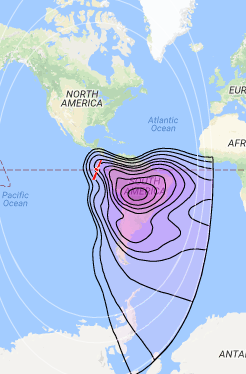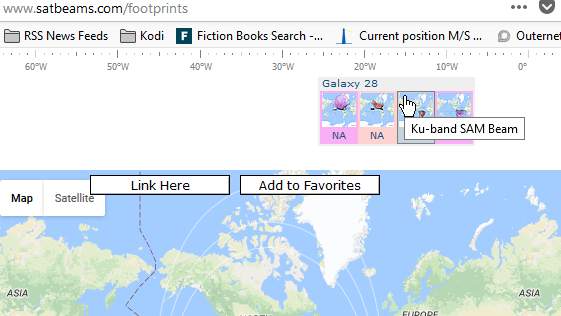NSS-7 looks good for europe. Would be 27° for me here in Germany. 
G28 may be the better bet with heaver and better coverage of the entire USA and more of Canada and more bandwidth to go around to everyone so more data can be transmitted i say in the matter of more positives from G28 to take that one.
@tylerhoot What do you mean by heavier coverage of the USA? The bandwidth in either case is only what we pay for.
well i mean stronger transmission to the areas that are covered including all the USA and Canada. now that i have done more reading I am dumbfounded by the older spacecraft providing better coverage and for the fact of longevity the newer sat might be a better choice but then the coverage across north America would be worse so I am, kinda stuck in the middle…
Got It! So, we’ll use the names Echostar 9 and Galaxy 28.
I looked again, and found Galaxy 28 also appears to have a South American beam - -

so that would give more coverage out of the same bird. Ken
That’s C-band, so it would require a completely different antenna.
@Syed,
Let me preface this with a simple disclaimer: I’m very much a newbie at Satellite projects. I’m by no means an expert. I have two simple concerns:
Where it the target customer base?
Are neighboring satellites going to interfere with the desired satellite signal?
- We really need to look at what is the best signal coverage for the target audience.
Here is a population density map for North America. Which satellite covers the target population better? You may have a better customer base sample in your sales records. I understand that in the future you want to provide coverage for areas that are in the fly-over parts of this map, but initially, you will need to be able to target the masses of experimenters that will try this system out and perhaps take their outernet device with them camping or on trips across the country, etc.
- The other factor in my mind is the beamwidth of a raw LNB or a smaller, lower gain antenna. With a larger dish antenna, we can focus in on one satellite. With the smaller, lower gain antenna, we will have to contend seeing more than just one satellite. I guess the best way I can illustrate this is with this photo of Christmas lights.
With a satellite dish, we may be able to see just one of the Christmas lights at once. With the smaller, dish, our field of view may include three of those bulbs. If the neighboring satellite on the target frequency has a transponder also on the same frequency with the same polarization there may be more interference than if the neighboring satellite is using the opposite polarization, etc.
Will we see 6 degrees wide instead of just two? Will this bother us?
So where are the neighboring satellites?
a) EchoStar 9
119.0°W Anik F3 CKu 171215
DirecTV 7S Ku 150220
EchoStar 14 Ku 171223
121.0°W EchoStar 9/Galaxy 23 CKu 171219
123.0°W Galaxy 18
b) Galaxy 28
87.1°W SES 2 CKu 171209
TKSat 1 Ku 171005
89.0°W Galaxy 28 CKu 161211
91.0°W Galaxy 17 CKu 171121
Nimiq 6 Ku 18010
Maybe someone can chime in and tell me that I’m nuts, or help me understand better.
–Konrad, WA4OSH
The population density map was interesting, thanks. The lower gain antennas have a beam width greater than 30 degrees, soi you will be seeing a dozen other satellites, which will have services on the exact same frequency. That’s not a problem, as interference mitigation has been factored into the receiver.
Syed,
I vote for EchoStar 9. My primary locations are Texas and Maine.
73, Frank KR1ZAN
@KR1ZAN I’m surprised you would be interested in EchoStar 9 in Maine. Isn’t the elevation angle less than twenty degrees up there?
Syed based on this 27Mhz transponder having a coverage area approximately doing the USA plus a bit more, you will need like 40 Ku band transponders to do the equivalent whole world that you were able to do with 3 L-Band Inmarsat satellites…
I think as this is clearly a experimental technology you should pick the satellite that will give you the best TEST result that allows you to clearly demonstrate your technology. Trying to please every one at the beggining is a tricky business.
So my vote would go to the beam that provides the highest test signal.
@Syed
I think G28 covers where the hobbyists are.
I guess we’ll be seeing the entire string of Christmas lights instead of just the blue one 
–Konrad, WA4OSH
An antenna with wider beamwidth usually means less signal strength. Similarly, in a “rich field” telescope, you would see more stars of a cluster, but weaker in brightness. The two sciences are closely related.
…and we’ll obviously need to know how to separate the light from the blue one from the rest of them.
–Konrad, WA4OSH_
I like what @Seasalt implies for TEST — since we a demonstrating communications without a dish or pointing system, I think the highest power for satisfactory decoding is paramount. Then when more beams are added for worldwide coverage there may be areas that require some methods for higher gain receiving. I may be a contrarian on this forum since I like reliable reception with a sacrifice that it has lower data rates.
@Syed Thank you for catching my error. I do most of my reading on my iPad and need to stop doing that. I evaluated the elevation angles and bearings using a sat pointer app and made notes and got confused.
I change my vote to G28.
Also, any thoughts on the active “string” search for monitoring and alarms?
73, Frank KR1ZAN
There is nothing that needs to be done; the modem/demodulator takes care of that automatically.

